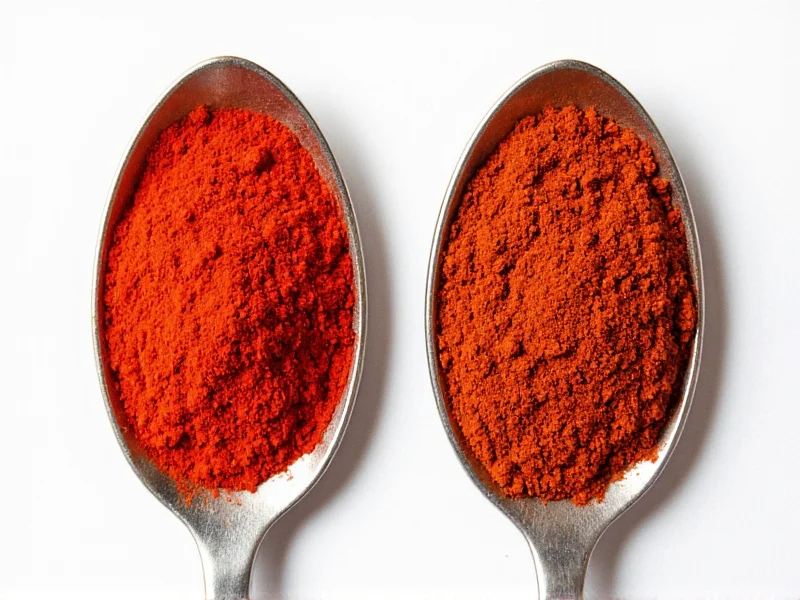Understanding the distinction between red chilli powder and cayenne pepper is essential for home cooks and professional chefs alike. While both appear similar in color and name, their heat levels, flavor characteristics, and culinary applications vary substantially. Using the wrong one can dramatically alter a dish's outcome—either leaving it bland or making it inedibly spicy. This comprehensive comparison examines their origins, heat measurements, flavor notes, nutritional content, and practical substitution guidelines to help you make informed cooking decisions.
What Exactly Are These Spices?
Red chilli powder, commonly used in Indian and Middle Eastern cuisines, typically consists of a blend of various dried red chili varieties. The specific mix varies by region and manufacturer, resulting in moderate heat with earthy, slightly sweet undertones. In contrast, cayenne pepper originates from specific Capsicum annuum varieties, primarily grown in Central and South America. Pure cayenne pepper contains only cayenne peppers, giving it a consistent, intense heat with bright, citrusy notes.
Heat Level Comparison
The most significant difference lies in their Scoville Heat Units (SHU), which measure capsaicin concentration:
| Spice | Scoville Heat Units | Relative Heat Level |
|---|---|---|
| Red Chilli Powder | 1,500-2,500 SHU | Mild to medium (similar to paprika) |
| Cayenne Pepper | 30,000-50,000 SHU | Very hot (10-20x hotter than red chilli powder) |
This dramatic difference means substituting one for the other without adjustment will significantly impact your dish. A teaspoon of cayenne contains as much heat as 10-20 teaspoons of standard red chilli powder.
Flavor Profiles and Culinary Applications
Red chilli powder offers a more complex flavor profile with earthy, slightly sweet, and smoky notes alongside its moderate heat. It's essential in Indian curries, Middle Eastern spice blends like za'atar, and Mexican adobo sauces. Chefs use it when they want chili flavor without overwhelming heat.
Cayenne pepper delivers a sharper, more immediate heat with citrusy and slightly fruity undertones. Its clean, direct heat makes it ideal for dishes where you want pronounced spiciness without competing flavors. Common applications include Cajun cuisine, hot sauces, and as a finishing spice for soups and stews.
Substitution Guidelines
When substituting between these spices, precise ratios are crucial:
- To replace cayenne with red chilli powder: Use 3-4 teaspoons of red chilli powder for every 1/4 teaspoon of cayenne
- To replace red chilli powder with cayenne: Use 1/8 teaspoon cayenne for every 1 teaspoon of red chilli powder
- For authentic regional dishes: Avoid substitution when possible—Indian recipes specifically call for red chilli powder for good reason
Always add cayenne gradually and taste as you go. Its heat builds more slowly than red chilli powder but ultimately becomes much more intense.
Nutritional Differences
Both spices contain capsaicin, which offers potential health benefits including metabolism boost and anti-inflammatory properties. However, cayenne contains significantly higher capsaicin levels due to its concentrated heat. Per tablespoon:
- Red chilli powder: Approximately 15-25 calories, 1-2g fiber, moderate vitamin A
- Cayenne pepper: Approximately 18-30 calories, 2-3g fiber, higher vitamin A and C content
The higher capsaicin content in cayenne may provide stronger metabolic effects, but both contribute similar antioxidant compounds found in chili peppers.
Common Misconceptions Clarified
Several myths persist about these spices:
- Misconception: Red chilli powder is just milder cayenne
Reality: They come from different pepper varieties with distinct flavor profiles - Misconception: All "chili powder" is the same worldwide
Reality: American chili powder often contains cumin and garlic, while Indian red chilli powder is pure ground chilies - Misconception: You can substitute equal amounts
Reality: The heat difference requires careful ratio adjustments to avoid ruining dishes
Practical Cooking Tips
For best results:
- Store both spices in airtight containers away from light and heat to preserve flavor
- Bloom red chilli powder in oil first to enhance its earthy flavors
- Add cayenne toward the end of cooking to preserve its bright heat
- When in doubt about heat level, start with half the recommended amount and adjust
- Consider regional authenticity—Indian recipes need proper red chilli powder, not cayenne
When to Choose Which Spice
Select red chilli powder when:
- Preparing authentic Indian, Middle Eastern, or Mexican dishes
- You want chili flavor without intense heat
- Creating complex spice blends where chili is one component
Choose cayenne pepper when:
- You need pronounced, direct heat
- Preparing Cajun, Creole, or certain American dishes
- Adding heat without introducing additional flavor notes
- Creating hot sauces or spice rubs where intense heat is desired











 浙公网安备
33010002000092号
浙公网安备
33010002000092号 浙B2-20120091-4
浙B2-20120091-4